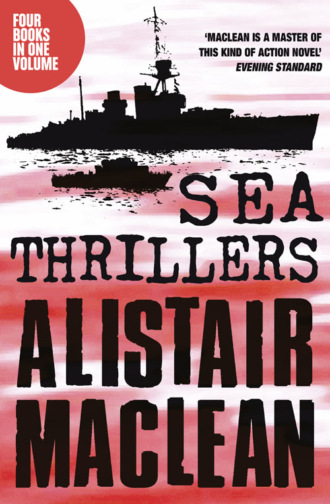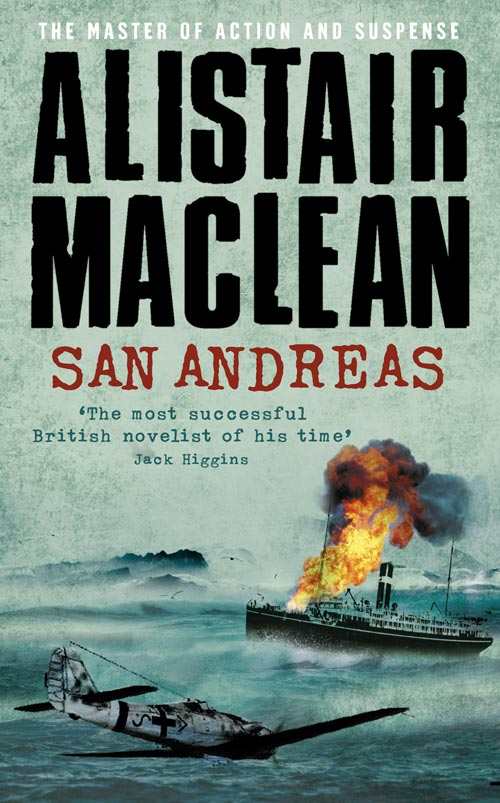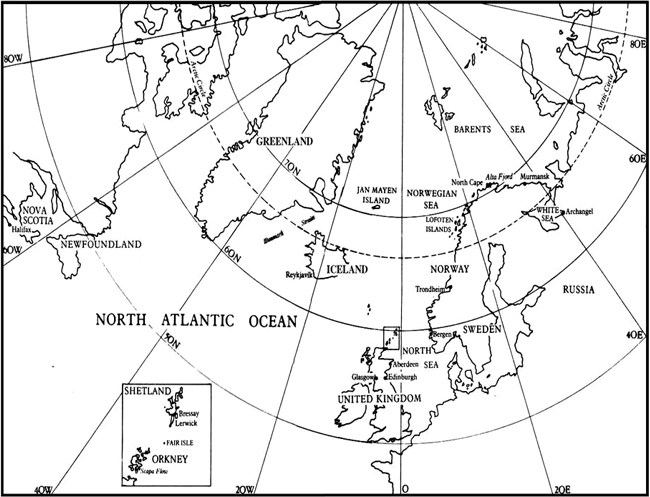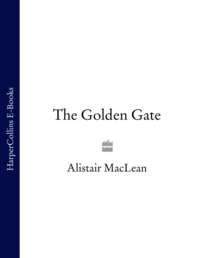
Полная версия
Alistair MacLean Sea Thrillers 4-Book Collection: San Andreas, The Golden Rendezvous, Seawitch, Santorini

ALISTAIR MACLEAN
Sea Thrillers
San Andreas The Golden Rendevous Seawitch Santorini

Table of Contents
Cover
Title Page
San Andreas
The Golden Rendezvous
Seawitch
Santorini
About the Author
Also by the Author
Copyright
About the Publisher

ALISTAIR MACLEAN
San Andreas

Dedication
To David and Judy
Table of Contents
Cover
Title Page
Dedication
Map
Prologue
Chapter One
Chapter Two
Chapter Three
Chapter Four
Chapter Five
Chapter Six
Chapter Seven
Chapter Eight
Chapter Nine
Chapter Ten
Chapter Eleven
Chapter Twelve
Chapter Thirteen
Map

Prologue
There are three distinct but inevitably interlinked elements in this story: the Merchant Navy (officially the Mercantile Marine) and the men who served in it: Liberty Ships: and the units of the German forces, underseas, on the seas and in the air, whose sole mission was to seek out and destroy the vessels and crews of the Merchant Navy.
1 At the outbreak of war in September 1939 the British Merchant Navy was in a parlous state indeed – ’pitiable’ would probably be a more accurate term. Most of the ships were old, a considerable number unseaworthy and some no more than rusting hulks plagued by interminable mechanical breakdowns. Even so, those vessels were in comparatively good shape compared to the appalling living conditions of those whose misfortune it was to serve aboard those ships.
The reason for the savage neglect of both ships and men could be summed up in one word – greed. The fleet owners of yesteryear – and there are more than a few around today – were grasping, avaricious and wholly dedicated to their high priestess – profits at all costs, provided that the cost did not fall on them. Centralization was the watchword of the day, the gathering in of overlapping monopolies into a few rapacious hands. While crews’ wages were cut and living conditions reduced to barely subsistence levels, the owners grew fat, as did some of the less desirable directors of those companies and a considerable number of carefully hand-picked and favoured shareholders.
The dictatorial powers of the owners, discreetly exercised, of course, were little short of absolute. Their fleets were their satrap, their feudal fiefdom, and the crews were their serfs. If a serf chose to revolt against the established order, that was his misfortune. His only recourse was to leave his ship, to exchange it for virtual oblivion, for, apart from the fact that he was automatically blackballed, unemployment was high in the Merchant Navy and the few vacancies available were for willing serfs only. Ashore, unemployment was even higher and even if it had not been so, seamen find it notoriously difficult to adapt to a landlubber’s way of life. The rebel serf had no place left to go. Rebel serfs were very few and far between. The vast majority knew their station in life and kept to it. Official histories tend to gloss over this state of affairs or, more commonly, ignore it altogether, an understandable myopia. The treatment of the merchant seamen between the wars and, indeed, during the Second World War, does not form one of the more glorious chapters in British naval annals.
Successive governments between the wars were perfectly aware of the conditions of life in the Merchant Navy – they would have had to be more than ordinarily stupid not to be so aware – so successive governments, in largely hypocritical face-saving exercises, passed a series of regulations laying down minimum specifications regarding accommodation, food, hygiene and safety. Both governments and owners were perfectly aware – in the case of the ship-owners no doubt cheerfully aware – that regulations are not laws and that a regulation is not legally enforceable. The recommendations – for they amounted to no more than that – were almost wholly ignored. A conscientious captain who tried to enforce them was liable to find himself without a command.
Recorded eyewitness reports of the living conditions aboard Merchant Navy ships in the years immediately prior to the Second World War – there is no reason to question those reports, especially as they are all so depressingly unanimous in tone – describe the crews’ living quarters as being so primitive and atrocious as to beggar description. Medical inspectors stated that in some instances the crews’ living quarters were unfit for animal, far less human, habitation. The quarters were invariably cramped and bereft of any form of comfort. The decks were wet, the men’s clothes were wet and the mattresses and blankets, where such luxuries were available, were usually sodden. Hygiene and toilet facilities ranged from the primitive to the non-existent. Cold was pervasive and heating of any form – except for smoking and evil-smelling coal stoves – was rare, as, indeed was any form of ventilation. And the food, which as one writer said would not have been tolerated in a home for the utterly destitute, was even worse than the living quarters.
The foregoing may strain the bounds of credulity or, at least, seem far-fetched, but respectively, they should not and are not. Charges of imprecision and exaggeration have never been laid at the doors of the London School of Hygiene and Tropical Medicine or the Registrar General. The former, in a pre-war report, categorically stated that the mortality rate below the age of fifty-five was twice as high for seamen as it was for the rest of the male population, and statistics issued by the latter showed that the death rate for seamen of all ages was 47% in excess of the national average. The killers were tuberculosis, cerebral hæmorrhage and gastric or duodenal ulcers. The incidence of the first and last of those is all too understandable and there can be little doubt that the combination of those contributed heavily to the abnormal occurrence of strokes.
The prime agent of death was unquestionably tuberculosis. When one looks around Western Europe today, where TB sanatoria are a happily and rapidly vanishing species, it is difficult to imagine just how terrible a scourge tuberculosis was just over a generation ago. It is not that tuberculosis, worldwide, has been eliminated: in many underdeveloped countries it still remains that same terrible scourge and the chief cause of death, and as recently as the early years of this century TB was still the number one killer in Western Europe and North America. Such is no longer the case since scientists came up with the agents to tame and destroy the tubercle bacillus. But in 1939 it was still very much the case: the discovery of the chemotherapeutic agents, rifampin, para-aminosalicylic acid, isoniazid and especially streptomycin, still lay far beyond a distant horizon.
It was upon those tuberculosis-ridden seamen, ill-housed and abominably fed, that Britain depended to bring food, oil, arms and ammunition to its shores and those of its allies. It was the sine qua non conduit, the artery, the lifeline upon which Britain was absolutely dependent: without those ships and men Britain would assuredly have gone under. It is worth noting that those men’s contracts ended when the torpedo, mine or bomb struck. In wartime as in peacetime the owners protected their profits to the bitter end: the seaman’s wages were abruptly terminated when his ship was sunk, no matter where, how, or in what unimaginable circumstances. When an owner’s ship went down he shed no salt tears, for his ships were insured, as often as not grossly over-insured: when a seaman’s ship went down he was fired.
The Government, Admiralty and ship-owners of that time should have been deeply ashamed of themselves: if they were, they manfully concealed their distress: compared to prestige, glory and profits, the conditions of life and the horrors of death of the men of the Merchant Navy were a very secondary consideration indeed.
The people of Britain cannot be condemned. With the exception of the families and friends of the Merchant Navy and the splendid volunteer charitable organizations that were set up to help survivors – such humanitarian trifles were of no concern to owners or Whitehall – very few knew or even suspected what was going on.
2 As a lifeline, a conduit and an artery, the Liberty Ships were on a par with the British Merchant Navy: without them, Britain would have assuredly gone down in defeat. All the food, oil, arms and ammunition which overseas countries – especially the United States – were eager and willing to supply were useless without the ships in which to transport them. After less than two years of war it was bleakly apparent that because of the deadly attrition of the British Merchant fleets there must soon, and inevitably, be no ships left to carry anything and that Britain would, inexorably and not slowly, be starved into surrender. In 1940, even the indomitable Winston Churchill despaired of survival, far less ultimate victory. Typically, the period of despair was brief but heaven only knew that he had cause for it.
In nine hundred years, Britain, of all the countries in the world, had never been invaded, but in the darkest days of the war such invasion seemed not only perilously close but inevitable. Looking back today over a span of forty and more years it seems inconceivable and impossible that the country survived: had the facts been made public, which they weren’t, it almost certainly would not.
British shipping losses were appalling beyond belief and beggar even the most active imagination. In the first eleven months of the war Britain lost 1,500,000 tons of shipping. In some of the early months of 1941, losses averaged close on 500,000 tons. In 1942, the darkest period of the war at sea, 6,250,000 tons of shipping went to the bottom. Even working at full stretch British shipyards could replace only a small fraction of those enormous losses. That, together with the fact that the number of operational U-boats in that same grim year rose from 91 to 212 made it certain that, by the law of diminishing returns, the British Merchant Navy would eventually cease to exist unless a miracle occurred.
The name of the miracle was Liberty Ships. To anyone who can recall those days the term Liberty Ships was automatically and immediately linked with Henry Kaiser. Kaiser – in the circumstances it was ironic that he should bear the same name as the title of the late German Emperor – was an American engineer of unquestioned genius. His career until then had been a remarkably impressive one: he had been a key figure in the construction of the Hoover and Coulee dams and the San Francisco bridge. It is questionable whether Henry Kaiser could have designed a rowing-boat but that was of no matter. He almost certainly had a better understanding of prefabrication based on a standard and repeatable design than any other person in the world at the time and did not hesitate to send out contracts for part-construction to factories in the United States that lay hundreds of miles from the sea. Those sections were transmitted to shipyards for assembly, originally to Richmond, California, where Kaiser directed the Permanente Cement Co., and eventually to other shipyards under Kaiser’s control. Kaiser’s turnover and speed of production stopped just short of the incredible: he did for the production of merchant vessels what Henry Ford’s assembly lines had done for the Model T Ford. Until then, as far as ocean-going vessels were concerned, mass production had been an alien concept.
Mistakenly, but understandably, there existed a widely-held belief that the Liberty Ships originated in the design offices of the Kaiser shipyards. The design and prototypes were, in fact, English and were conceived by the design staff of the shipbuilders J.L. Thompson of North Sands, Sunderland. The first of what was to become a very long line indeed, the Embassage, was completed in 1935 – the prefix ‘Liberty’ did not come into existence for another seven years, and only for some of the Kaiser-built vessels. The Embassage, 9,300 tons, with a raked stem and rounded stern and three triple-expansion coal-burning engines, was a non-starter in the æsthetic stakes, but then J.L. Thompson were not interested in æsthetics: what they had aimed at was a modern, practical and economical cargo vessel and in this they succeeded admirably. Twenty-four more similar vessels were built before the outbreak of war.
Those ships were built in Britain, the United States and Canada, the great preponderance in the Kaiser yards. Hull designs remained identical but the Americans, and only the Americans, introduced two changes which they regarded as refinements. One of those changes, using oil instead of coal as fuel, may well have been: the other, which concerned the accommodation of officers and crew, was not. While the Canadians and British retained the original concept of having the living quarters both fore and aft the Americans elected to have all the crew, officers and men – and the navigating bridge – in a superstructure surrounding the funnel. In retrospect – hindsight and bitter experience make for a splendid conductor to belated wisdom – it was a blunder. The Americans had all their eggs in one basket.
Those vessels were armed – after a fashion. They had four-inch low-angle and twelve-pounder anti-aircraft guns, neither of which was particularly effective, together with Bofors and rapid-firing Oerlikons: the Oerlikons were deadly in trained hands – but there were few trained hands around. They also had weird devices such as rocket-fired parachutes and cables carrying coils of wire and grenades: these were as dangerous to those using them as the aircraft they were supposed to bring down. Some few of these ships had catapult-launched Hurricane fighters – the nearest equivalent to the suicidal Japanese kamikaze planes that Britain ever had. The pilots could not, of course, return to their ships: they had the uncomfortable option of either baling out or ditching. In the Arctic, in winter, their survival rate was not high.
3 From the air, on the sea and under the sea the Germans, often with brilliance, always with tenacity and ruthlessness, used every means in their power to destroy the Merchant Navy convoys.
Basically, they used five main types of aircraft. Their standard or conventional bomber was the Dornier which flew at pre-determined heights and released their bombs in pre-determined patterns: they were useful planes and had their successes but were not particularly effective.
Much more feared, in ascending order, were the Heinkel, the Heinkel III and the Stuka. The Heinkel was a torpedo-bomber, which attacked at wave-top level, its pilot releasing the torpedo at the last possible moment, then using the lightened weight of his aircraft to lift over the ship it was attacking. Those planes had an unusual degree of immunity from destruction: when the anti-aircraft gunners on the merchant ships peered over the sights of their Oerlikons, Bofors or pom-poms – two-pounders – the thought that ‘He gets me or I get him’ didn’t make for the degree of cool detachment which would have been helpful in the circumstances. In the Arctic winter, those torpedo-bombers were not infrequently at a disadvantage, especially for the gallant but unfortunate pilots who flew them: ice could freeze up their torpedo release mechanisms and their burdened aircraft were unable to lift off over their targets. This made little difference to the equally unfortunate crews of the merchant vessels: whether the torpedo was running free or still attached to the aircraft when it crashed into the ship, the results were equally devastating.
The Heinkel III used glider bombers. These were highly effective, exposed their pilots to a much lesser degree of risk and the bombs, once released, were virtually impossible to shoot down: fortunately for the Merchant Navy, the Germans did not have too many of these highly specialized planes.
The Stuka, the dihedral – gull-winged Junker 87 dive-bomber – was the most feared of all. It was their customary practice to fly at high altitude in level formation, then peel off successively in near-vertical dives. Forty years later, the seamen and soldiers – the Germans used the Junker 87 in every theatre of war – who survived those attacks and are still alive will never forget the sound of the banshee shrieking as the Stuka pilots switched on their sirens in their plummeting dive. The sound, to say the least, was unnerving and considerably reduced the effectiveness of anti-aircraft gunners. The Royal Navy used searchlights, customarily of the 44-inch variety, in an attempt to blind the Stuka pilots, until it was pointed out to them that the pilots, who were well aware of this tactic, used dark glasses to reduce the blinding glare to mere pinpoints of light which enabled them to home in even more accurately on their targets. From the German point of view the Stukas had only one drawback: they were essentially short-range planes and could operate effectively only against convoys moving to the north of Norway en route to Murmansk and Archangel.
But, oddly enough, the most effective air weapon the Germans had was the essentially non-combative Focke-Wulf Condor 200. True, it could and did carry 250-kilo bombs and had a fairly formidable array of machine-guns, but with bombs removed and extra fuel tanks fitted in their place, it became an invaluable reconnaissance plane. For that comparatively early flying era, in the early Forties, its flying range was quite remarkable. Condors flew almost daily from Trondheim, in German-occupied Norway, round the western coast of the British Isles to German-occupied France: more importantly, they were capable of patrolling the Barents Sea, the Greenland Sea and, most damagingly of all, the justly dreaded Denmark Strait, between Iceland and Greenland, for it was through that strait that the Russian-bound convoys from Canada and the United States passed. For such a convoy, the sight of a Condor was the guarantee of inevitable disaster.
Flying high and safely out of reach of antiaircraft fire, the Condor would literally circle the convoy, its crew noting down the number of ships, the convoy’s speed, course and precise latitude and longitude. This information was radioed to Alta Fjord or Trondheim and then transmitted to Lorient, the French HQ of Admiral Karl Doenitz, almost certainly the best submarine C-in-C of his time or any time. From there the information was re-transmitted to the growing submarine wolfpack or packs, instructing them when and where exactly to position themselves to intercept the convoy.
As far as surface warships were concerned, the Germans were more than adequately prepared at the outbreak of war. By the Anglo-German agreement of 1937 Germany could build 100% of the British equivalent of submarines but only 35% of surface ships. In fact they built twice as many submarines and completely ignored the other 35% restriction. The Deutschland, Admiral Graf Spee and Admiral Scheer were nominally 10,000 ton cruisers: they were, in fact, fast and powerful commerce raiders, in effect pocket battleships of a far greater tonnage than purported. The Scharnhorst and Gneisenau, 26,000 ton battle-cruisers, were completed in 1938 and it was in that year that the Bismarck and Tirpitz were laid down in the Blohm and Voess shipyards in Hamburg. Those were the best and most powerful battleships ever built, a statement that remains true to this day. By treaty limitations they were restricted to 35,000 tons: they were, in fact, 53,000 tons.
The Bismarck had a brief but spectacular career, the Tirpitz no career at all. It spent its war holed up in northern Norway, where it none the less performed the invaluable function of tying up major units of the British Home Fleet which feared that the giant battleship might slip its moorings in Alta Fjord and break out into the Atlantic. It was at those moorings that the Tirpitz was ultimately destroyed by ten-ton bombs from RAF Lancasters.
Although the British had a very considerable advantage in battleships, they were, individually, no match for those of the Germans, as was tragically proved when the Bismarck sank the battle-cruiser Hood, pride and darling of the Royal Navy, with a single salvo.
Underwater, the Germans used mines and submarines. Less than three months after the outbreak of war the Germans had come up with a rather unpleasant device – the magnetic mine. Unlike the standard type, which had to come into physical contact with a vessel before being activated, the magnetic mine was set off by the electrical current generated by the ship’s hull. Those mines could be laid by either ships or aircraft and in the first four days after their introduction no fewer than fifteen ships were sent to the bottom – the fact that they were nearly all neutrals seemed of no great concern to the Germans: magnetic mines are very clever devices but not clever enough to discriminate between a neutral and an enemy. The British managed to retrieve one intact, took it to pieces – not without considerable danger to those engaged in the dismantling – and came up with electronic counter-measures which enabled minesweepers to detonate the magnetic mine at a respectful distance.
Submarines, of course, were the most deadly enemies the Merchant Navy had to face. The toll taken in the first three and a half years of war was savage beyond belief. It wasn’t until the early summer of 1943 that the menace was brought under some form of control, but it wasn’t until the end of 1944 – during the two years 1943–4 480 German submarines were destroyed – that those stealthy pursuers and silent killers ceased to be a factor of consequence.
It was inevitable that the U-boats should be selected as the target for hatred and their crews depicted, both during the war and subsequently, as cunning, treacherous and ice-cold murderers, fanatical Nazis to a man, who hunted down unsuspecting innocents, closed in unheard and unseen, destroyed their victims without mercy or compunction, then moved on again, still unheard and unseen. To a limited extent, this view was valid. The pattern for this belief was set on the very first day of the war when the liner Athenia was torpedoed. In no way could the Athenia have been mistaken for anything other than what it was: a peaceful passenger vessel crammed with civilians – men, women and children. This must have been known to the far from gallant Oberleutnant Fritz-Julius Lemp, commander of the German U-boat that sent the Athenia to the bottom. There is no record that Lemp was ever reprimanded for his action.








